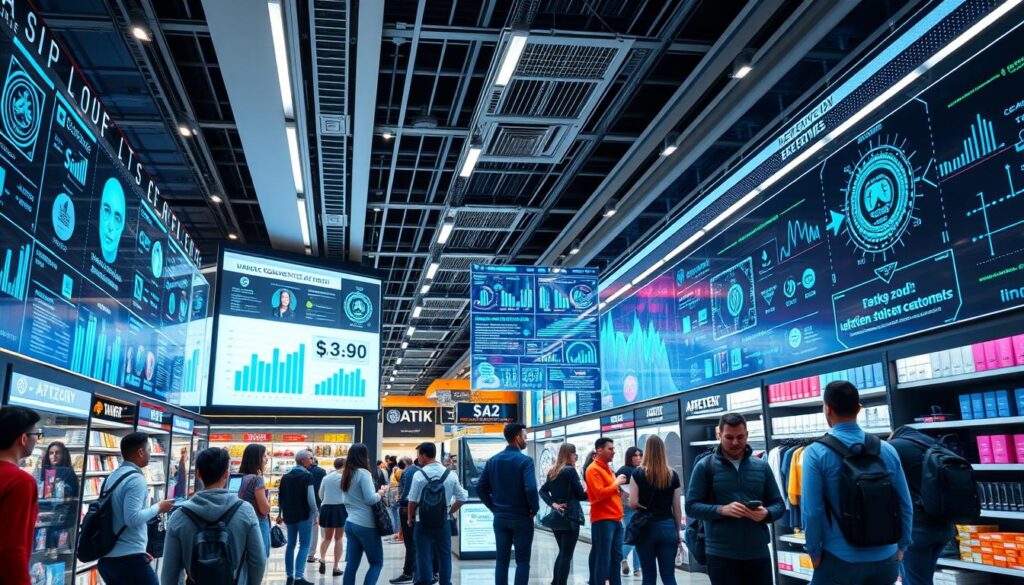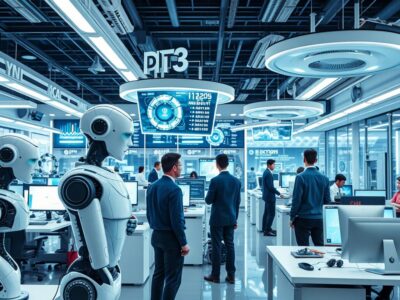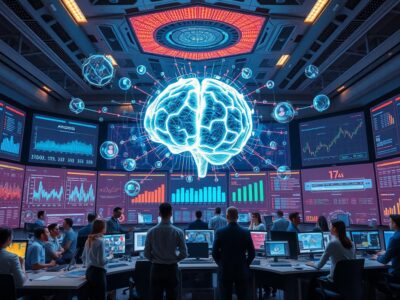Artificial intelligence technology is rapidly shaping the future of business. It serves as a crucial driver for enhancing performance. By improving productivity and making workflows smoother, AI helps companies make the most of Robotic Process Automation (RPA). This automation of everyday tasks not only improves how companies work but also fosters a setting where innovation thrives.
With the rise of AI-driven methods, we’re seeing new chances for enhancing performance on a big scale. In the race to be the best, using artificial intelligence puts companies ahead in achieving operational greatness. As managing data and meeting operational needs become more complex, firms turn to these solutions to succeed and flourish.
Key Takeaways
- AI-driven strategies are setting new standards in operational efficiency.
- Performance optimization solutions powered by AI are transformative across various industries.
- The strategic deployment of RPA underpins the heightened accuracy and productivity.
- Continuous advancement of AI capabilities fuels innovation and competitive advantage.
- Artificial intelligence technology facilitates a foundational change in business operations.
Understanding the AI Technological Frontier and Worker Performance
The world of work is changing fast because of new AI tools. These tools, like generative pretrained transformers and cognitive computing, aim to make things better. They do this by doing routine jobs and giving deep insights. Yet, their effect on how well workers do depends a lot on the job’s complexity and what the AI can do.
The Defining Capabilities of Generative AI
Generative pretrained transformers are changing the way we do tasks at work. They are really good at creating text and ideas that seem human-like, based on the data they get. This makes creating content and being creative easier in many areas. For example, in consulting jobs where thinking of creative solutions is important, AI help makes consultants do better. It does this by improving how well and quickly they do their jobs.
The Dual Impact of AI: When Performance Soars and When It Dips
Using AI in work, like predictive analytics, can have different results. About 64% of businesses see AI as a way to make more work get done. But, there’s a downside too. If AI is used for things it’s not best at, workers may feel left behind. This can make them less involved at work. This lack of involvement is costly for the global economy. So, it’s important to use AI the right way.
The Role of Cognitive Effort and Expert Judgment
To really benefit from AI, people need to think hard and use their expertise. This teamwork between humans and AI is key, especially in jobs that need care and understanding, like in healthcare. Here, AI can help but not take over from human decisions. Employees trained well to use AI can make the workplace better. This leads to more work getting done and everyone feeling happier about their jobs.
| Aspect | Impact of AI without Human Engagement | Impact of AI with Human Engagement |
|---|---|---|
| Performance Quality | Decreases | Increases 40% |
| Employee Satisfaction | Decreases | Increases with Effective Training |
| Content Production | Generic Outputs | Creative, High-Quality Outputs |
| Task Automation | Limited to Routine Tasks | Extends to Complex Problem Solving |
As AI keeps changing fast, businesses should train their people well. They need to mix AI with human creativity and insight. This helps reach the business’s goals. It also creates a workplace where innovation and satisfaction grow together.
Strategic Integration of AI: Managerial Insights and the Organizational Approach
Integrating artificial intelligence (AI) into organizations requires focused management. This involves understanding the organization’s structure deeply. Managers play a key role in using smart automation tools and advanced analytics software.
They must commit to creating a culture of accountability. It’s essential that AI’s introduction fits with the business goals.
The Importance of Interface Design and User Onboarding
Good interface design makes navigating advanced analytics software simpler. It makes complex data easy to grasp. The aim is to meet technical needs while being user-friendly.
User onboarding is crucial. It includes training that highlights new systems’ benefits. For example, AI can improve strategy management and market analysis.
Focused user training boosts the adoption and success of these technologies. This leads to notable data-driven performance improvements.
The Necessity of Role Reconfiguration and a Culture of Accountability
With the evolution of AI, like predictive analytics, roles need to change. Organizations must adjust roles to fit a collaborative model. This helps integrate AI tools and improves decision-making.
To create a culture of accountability, communicate openly. Share regular updates on AI projects and their outcomes. Such a culture boosts engagement and supports both human and AI collaboration.

In summary, strategically incorporating AI requires a structured managerial approach. Success comes from good interface design, solid user training, adaptable role configuration, and strong accountability. These elements help achieve data-driven performance improvements. They keep companies competitive in the digital age.
Quantitative Data: How AI-Driven Performance Enhancements Are Measured
In modern business, machine learning algorithms are more than just tools. They change the game by reshaping performance optimization. Through quantitative data, firms can see data-driven performance improvements. This boosts efficiency and productivity in different areas.
It’s important to understand the metrics used to see these advantages. Metrics such as accuracy, precision, and recall are key. Accuracy checks the true results ratio, making AI’s decisions trustworthy. Precision is important when a false positive’s cost is high. It looks at how correct positive predictions are. Recall, or sensitivity, is crucial in healthcare to avoid missing any positive cases.
The F1 Score combines precision and recall for a balanced model effectiveness view. It’s useful with imbalanced datasets. The Area Under the ROC Curve (AUC-ROC) shows binary classification systems’ overall performance.
Firms also use metrics like Mean Absolute Error (MAE), Mean Squared Error (MSE), and Root Mean Squared Error (RMSE). These assess continuous data predictions. They refine machine-learning models for better performance solutions.
Now, assessing AI systems’ transparency and fairness is standard. Tools like IBM’s AIX360 offer fairness metrics and bias strategies. ART helps defend against adversarial attacks.
Applying advanced metrics has helped various industries:
- Adobe: Increased recurring revenue by 20% with customer-focused marketing strategies.
- Starbucks: Boosted mobile orders by 21% by enhancing digital engagement.
- Walmart: Cut inventory costs by 10% using predictive analytics.
- Netflix: Increased sign-ups by 28% by customizing viewer content.
These successes show how AI and machine learning boost business. By improving data-driven performance, companies stay ahead. They achieve long-term success and edge out competitors in their fields.
AI-Driven Performance Enhancements: Industry Case Studies and Success Stories
AI has changed many parts of business across various sectors. It has transformed how we interact with technology and improved our forecasting abilities. These case studies show how integrating AI doesn’t just change strategies. It also leads to big improvements in productivity and how things operate.
Revolutionizing Customer Engagement Through AI
Netflix is at the forefront with its use of AI to make better content suggestions. This has made users stick around more and helped Netflix earn more from subscriptions. Alibaba also uses AI to make customers happier and streamline how things are done, leading to more revenue.

Data Analysis and Insights: Understanding Customer Behavior
Amazon uses AI to sort through lots of data which improves how it manages inventory and speeds up deliveries. This makes customers happier. JPMorgan Chase uses AI for risk management. It helps them spot and stop fraud, cutting losses and making their risk management better.
Automating Repetitive Tasks and Improving Operational Efficiency
Ocado is using AI to do repetitive tasks faster and with fewer mistakes in their grocery delivery. This makes customers happier and lets Ocado move workers to more important jobs. This boosts how well everything runs.
| Company | AI Integration | Outcome |
|---|---|---|
| Netflix | Content Personalization | Increased engagement and revenue |
| Alibaba | Customer Interaction AI | Enhanced satisfaction and revenue growth |
| Amazon | Predictive Analytics | Optimized inventory and faster deliveries |
| JPMorgan Chase | Risk Management Algorithms | Reduced losses from fraud |
| Ocado | Automation in Logistics | Increased efficiency and accuracy |
These stories highlight the key role of AI in not just improving tasks but in changing whole industries. As AI gets even better, we can expect even more achievements in how efficiently and innovatively things are done.
The Future of Work: Skills Gap Narrowing and Advanced Learning through AI
We are seeing big changes in work due to artificial intelligence technology. Technologies like cognitive computing solutions and smart automation tools are transforming jobs. They create new chances for learning and growth.
A McKinsey report says automation might replace 800 million jobs by 2030. Yet, it also leads to new jobs, like over 700,000 in the U.S. mobile app sector. This situation offers both a challenge and a chance to learn more through AI.
Using artificial intelligence technology in business platforms has big benefits. It lets employees skip the boring tasks and do more interesting work. This change boosts productivity and makes work more fulfilling.
| Task Type | Economic Attractiveness for Automation | Typical Industries |
|---|---|---|
| Barcode Scanning | High | Retail, Warehousing |
| Facial Expression Recognition | Low | Security, Human Resources |
| Handwriting Recognition | Low | Education, Postal Services |
With jobs getting automated, we need more sophisticated cognitive skills. Cognitive computing solutions and smart automation tools can’t give us these skills by themselves. We must keep learning and improving our knowledge to keep up.
Even areas slow to adopt automation, like healthcare and law, are now using artificial intelligence technology. This doesn’t replace people but adds to their skills. It’s a win-win for AI technology and workers.
In conclusion, AI is changing the future of work. The key to succeeding in this new era is combining smart automation tools with ongoing learning. Aligning tech solutions with educational programs will maximize the benefits of human and artificial intelligence.
Conclusion
The use of AI in business is changing the game. Companies that use predictive analytics and data analysis see big benefits. They’re making better plans, working more efficiently, and earning more money. Studies show they cut costs by up to 20% and boost productivity by 20-25%. This is thanks to AI’s accuracy and flexibility.
AI technologies like those from ClearPoint Strategy improve business tasks and encourage teamwork. They make it easier to manage projects and reports. Retail businesses, for example, have seen a jump in sales by 30% or more. This shows AI’s wide-reaching advantages, not just for internal processes but also in understanding customers better.
Businesses that adopt AI-driven performance enhancements are ready for today’s challenges. They’re also setting the stage for a future where learning and growth matter a lot. With AI’s role in performance management growing, and predictive analytics set to skyrocket, the importance of AI is undeniable. Organizations must adopt AI solutions not just to keep up, but to excel in a data-driven world.
FAQ
How do AI-driven performance enhancements boost efficiency?
AI-driven enhancements make work faster by handling routine tasks. They also make workflows better and help with tough decisions. This boosts productivity and cuts down errors. So, operations run smoother and companies can quickly adapt to changes.
What are the defining capabilities of generative AI?
Generative AI can create outputs that seem like they were made by humans. It learns and gets better over time. This AI helps with creative tasks like making content, designing, and planning strategies.
How does worker performance vary with AI involvement?
Worker performance improves with AI help, as tasks get automated. This leads to better job completion. But, if AI is used wrong, it can make things worse. It’s key to use AI right to boost human skills.
Why is cognitive effort and expert judgment crucial when employing AI?
These are key because they help use AI wisely and safely. People need to understand AI’s advice, make choices, and check AI’s work. This ensures AI matches the company’s values and ethics.
What is the significance of interface design and user onboarding for AI integration?
Good design and training matter a lot. They make it easier for staff to use AI tools. This helps everyone get on board faster and use the new tech well.
How are AI-driven performance enhancements measured?
These improvements are checked by looking at productivity, fewer errors, and time saved. They also look at the effects on company goals. This shows how well the AI is working.
Can you provide industry case studies that demonstrate the success of AI-driven performance enhancements?
Yes, there are success stories across many fields. For instance, retail uses AI for better inventory control. Healthcare uses it to help diagnose sickness faster. And, finance uses AI to spot fraud. These cases show AI can really help specific areas do better.
How does AI help in narrowing the skills gap and advancing learning?
AI takes over simple tasks, so people can work on more important things. It also offers personalized learning and on-the-job training. This helps everyone learn more and grow in their careers.



